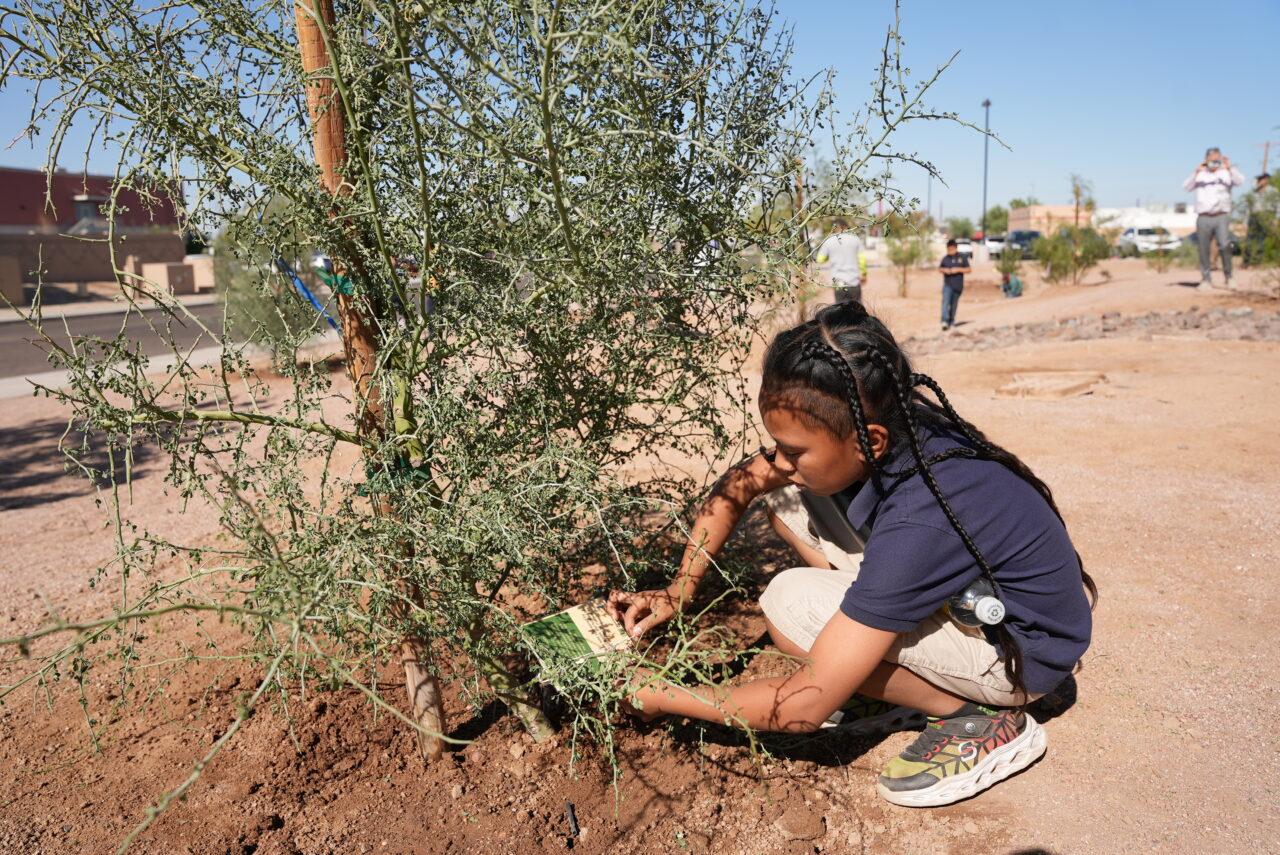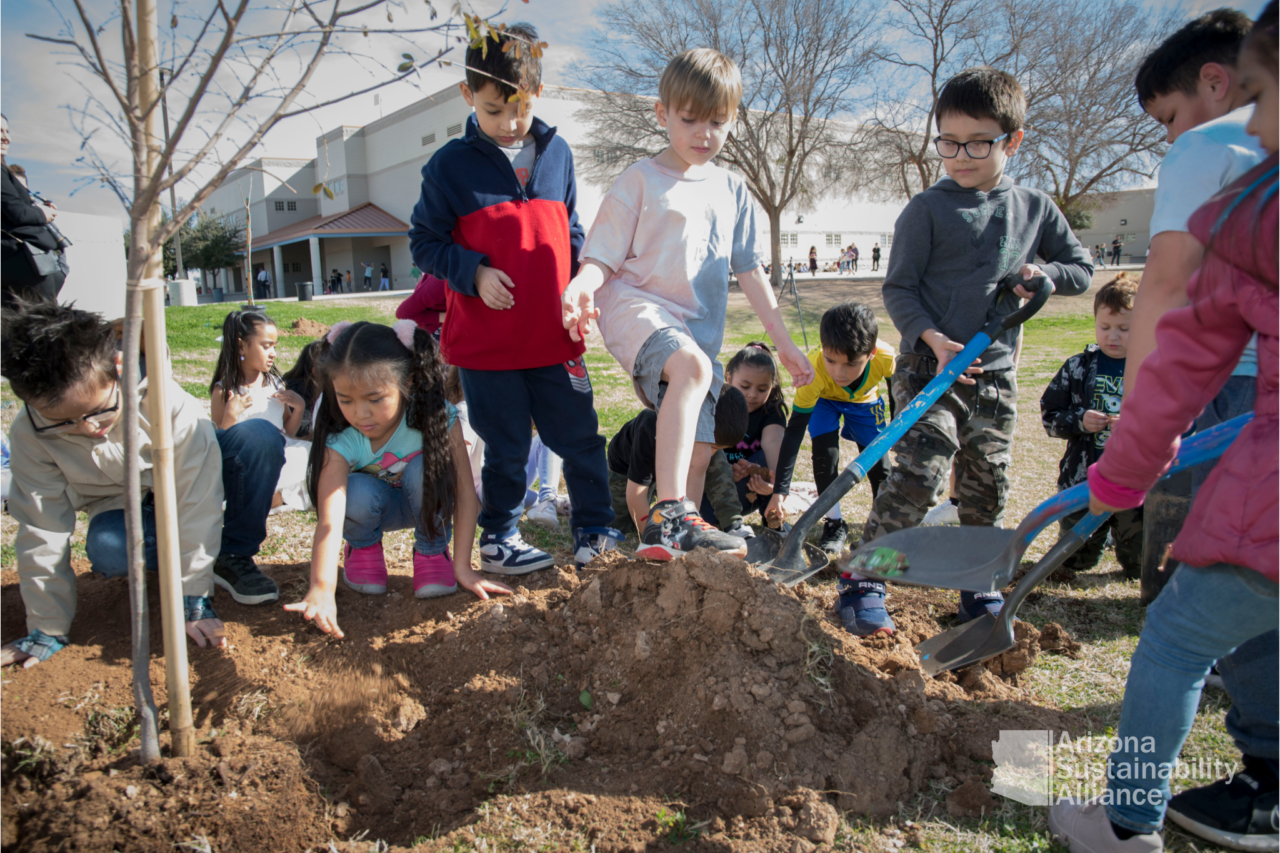When Jake Simon moved back to Arizona with his family in November 2020, he says it was “like coming home.” As an arborist and School of Forestry alum at Northern Arizona University in Flagstaff, Jake soon observed the disparity of tree cover in Maricopa County, an area the size of Vermont that more than 4.5 million people call home.
“Places like Paradise Valley have a Tree Equity Score of 100, and you almost wouldn’t know you are in the desert: it’s lush and well maintained and highly irrigated. But drive 30 minutes southwest to south central Phoenix, and there is a stark contrast – if there are any trees, they are often stunted or nearly dead. There are huge, huge disparities in all kinds of equity.”
Arizona’s landscape is incredibly diverse – “You can go from the desert to over 7,000 feet in elevation in under two hours,” Jake says. And while the state is not traditionally known for its forests, Coconino National Forest is home to the largest stand of Ponderosa Pine in the world. Unsurprisingly for the region, water and watershed management remain a major challenge, and as cities have increased in population and geographic area, “the built environment functions very differently than the natural environment,” Jake says. “In a lot of ways, it can be harsher than the desert.”
The urban heat island effect magnifies heat in America’s hottest city as the sun radiates off asphalt, and extreme heat is devastating the area. “The summer of 2023 was unprecedented in its heat. It is always hot in the desert, but it has never been this hot for this long.” With 31 straight days over 110 degrees in 2023, and 17 at or above 115 degrees, “many people essentially can’t go outside for any real length of time,” Jake says.

Photo Credit: Jonathan Elias on behalf of Paideia Academies
But the nights have also been brutal: during one stretch of the summer, temperatures did not dip below 90 degrees at night, including on July 19, when the temperature remained above 97 degrees. “We have never had the ‘low’ temperatures be so high. The lows are what is causing a lot of problems: people cannot cool off and the oppressive heat contributed to many of the iconic saguaro cacti dying off – they are not able to release their gasses and toxins at night and many rotted from the inside out.”
There were 645 heat related deaths recorded in Maricopa County in 2023 – a 52% increase over 2022. Heat related deaths outpaced even homicides; according to the Arizona Department of Public Safety, there were 404 homicides across the entire state last year.
And even winter offers little reprieve. “On December 5, in my backyard, in the shade, my thermometer outside was 88 degrees,” Jake says. “It’s not a short-term period. It is getting hotter sooner, and it is staying hotter longer throughout the year.”
In May 2023, Jake joined American Forests as the Senior Manager, Urban Forestry Southwest, taking on a leadership role within the Phoenix Metro Urban Forestry Roundtable, a coalition formed in 2019 in partnership between the nonprofit, the City of Phoenix, and the nonprofit Arizona Sustainability Alliance.
The efforts of our work at the Roundtable and our planting partners here truly are life and death for people. We’re really working not only to get trees planted where they are needed most but working with municipalities and governments here to see trees as critical, valuable infrastructure, similar to electric, gas and water lines.
– Jake Simon
“Having a well-treed neighborhood can bring the temperature down 8-10 degrees during the day and much more at night in areas where people without a well-canopied neighborhood are literally cooking.”
The Roundtable now consists of over 60 entities, from throughout Maricopa County, including municipalities, utility companies and homeowner associations. “We’re drawing in a lot of diverse people because urban forestry affects so many realms,” Jake says. “It’s truly the viewpoint that needs to change. Urban forestry has the potential to really help a lot of people – and not only is it important for conserving resources as a whole and the health and societal benefits of trees, but it is important for saving money by reducing cooling needs! We need people in the area to see trees less as a luxury or a ‘nice to have’ but instead see them as critical infrastructure.”
The Roundtable, which currently consists of a workforce development committee, tree species committee, municipalities committee and business partnerships committee, is working to approach urban forestry holistically, addressing nursery capacity; workforce challenges; urban forestry maintenance, inventories, and monitoring; climate adapted species identification; and stakeholder engagement.
“We need to build continuity across the valley in urban forestry practices and manage the urban forest as a whole unit and be strategic in our management methods,” Jake says. He heads up the business partnerships committee and the municipalities committee, which convenes cities to crowdsource and talk about upcoming funding or program opportunities, challenges they are facing or successes they’ve had. “It’s important to me that these committees aren’t just thought leaders, but that we’re also helping them get things done.”

Photo Credit: Arizona Sustainability Alliance
The committee is developing a guidebook of best practices for all things municipal forestry, from using Tree Equity Score and the newly debuted Tree Equity Score Analyzer (TESA) for Maricopa County to help prioritize planting and project areas to species selection; irrigation and maintenance methods; pruning; inventory and data management and contractor management. “Some smaller cities don’t have the bandwidth to research these things, but having a ready-made toolkit to help with contractor management and creating urban forestry master plans for the cities can make a big difference,” Jake says. The committee’s goal is to distribute the finalized toolkit in fall of 2024.
Similarly, the business partnerships committee will be developing a toolkit to raise awareness about Tree Equity, mobilize and drive engagement, and help connect businesses with funding, volunteers, and planting opportunities. The toolkit will also provide suggested guiding principles for businesses; an action guide for business leaders; and guidance on permitting, energy savings from shading, fundraising, and networking. Additionally, the toolkit will outline for businesses how to use TESA to show how much carbon newly planted trees will sequester once they mature, how much stormwater they will intercept, and how many jobs they will support.
Cities across the state are leading the way to make Tree Equity a reality: Phoenix was the first city in the nation to pledge to achieve Tree Equity and is in the process of updating their Tree and Shade Master Plan to include Tree Equity as a centralized focus of the efforts. Mesa has also committed to planting a million trees by 2050. “There’s a lot of factors that make the changes challenging to accomplish,” Jake says. “But there are great programs out there, and no matter what, we are going to plant a lot of trees,” uniting volunteers, education, community and youth engagement, funding opportunities and municipal engagement in the process.
Another promising development is the naming of Arizona’s first statewide Heat Officer, Dr. Eugene Livar. This role was appointed under Gov. Katie Hobbs’ extreme heat preparedness plan and will work to reduce the effects of extreme heat in the state and is the first statewide heat officer in the nation.
“This is a very exciting time,” Jake says. “We are getting a lot of synergy between committees and group members, and important conversations are happening more frequently. American Forests’ Maricopa County TESA debuted at a crucial time to facilitate decision making within the Roundtable and drive it forward.”
“We have a unique challenge, but the impetus behind it is so dire in a lot of ways that people really get it and are very eager to help. The realities of this summer really opened people’s eyes to the changes that are not only coming, but are already here, and that trees are an important way to mitigate them, while keeping an emphasis on equity.”